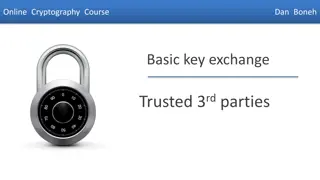Understanding RSA Public-key Cryptography in Data Encryption
Exploring the foundational concepts of RSA public-key cryptography and its applications in data encryption. Learn how messages can be encoded, transmitted securely, and decoded using encryption and decryption functions. Discover the significance of picking large primes and understanding the bijection concept for effective encryption. Dive into the properties and applications of RSA encryption in securing communications.
Download Presentation

Please find below an Image/Link to download the presentation.
The content on the website is provided AS IS for your information and personal use only. It may not be sold, licensed, or shared on other websites without obtaining consent from the author. Download presentation by click this link. If you encounter any issues during the download, it is possible that the publisher has removed the file from their server.
E N D
Presentation Transcript
MA/CSSE 473 Day 10 Data Encryption RSA
MA/CSSE 473 Day 10 Solution to Yesterday's quiz Student questions? Next Session, come prepared to discuss the interview with Donald Knuth (linked from the schedule page, Session 11) and Brute Force Algorithms and amortization Today: Cryptography Introduction RSA
We'll only scratch the surface, but there is MA/CSSE 479 CRYPTOGRAPHY INTRODUCTION
Cryptography Scenario You want to transmit a message m to me You encode the message and send it to me in a form e(m) that I can readily decode by running d(e(m)), Hopefully, a form that an eavesdropper has little chance of decoding Private-key protocols You and I meet beforehand and agree on e and d. Public-key protocols I publish an e for which I know the d, but it is very difficult for someone else to guess the d. Then you can use e to encode messages that only I* can decode * and anyone else who can figure out what d is, based on e
Messages can be integers Since a message is a sequence of bits We can consider the message to be a sequence of b-bit integers (where b is fairly large), and encode each of those integers. Here we focus on encoding and decoding a single integer.
RSA Public-key Cryptography Rivest-Shamir-Adleman (1977) References : Weiss, Section 7.4 Consider a message to be an integer modulo N, which has k bits (longer messages can be broken up into k-bit pieces) The encryption function will be a bijection on {0, 1, , N-1}, and the decryption function will be its inverse How to pick the N and the bijection? Dasgupta, Pages 33-34 bijection: a function f from a set X to a set Y with the property that for every y in Y, there is exactly one x in X such that f(x) = y. In other words, f is both one-to-one and onto.
N = p q Pick two large primes, p and q, and let N = pq. Property: If e is any number that is relatively prime to N' = (p-1)(q-1), then the mapping x xe mod N is a bijection on {0, 1, , N-1}, and If d is the inverse of e mod N',then for all x in {0, 1, , N-1}, (xe)d x (mod N). We'll first apply this property, then prove it.
Public and Private Keys The first (bijection) property tells us that x xe mod N is a reasonable way to encode messages, since no information is lost If you publish (N, e) as your public key, anyone can encode and send messages to you The second tells how to decrypt a message When you receive an encoded message m', you can decode it by calculating (m')d mod N.
Example (from Wikipedia) p=61, q=53. Compute N = pq = 3233 N' = (p-1)(q-1) = 60 52 = 3120 Choose e=17 (relatively prime to 3120) Compute multiplicative inverse of 17 (mod 3120) Thus d= 2753 (evidence: 17 2753 = 46801 = 1 + 15 3120) To encrypt m=123, take 12317 (mod 3233) = 855 To decrypt 855, take 8552753 (mod 3233) = 123 In practice, we would use much larger numbers for p and q. On exams, smaller numbers
Recap: RSA Public-key Cryptography Pick any two large primes, p and q, and let N = pq. Consider a message to be a number modulo N, a k-bit number (longer messages can be broken up into k-bit pieces) Property: If e is any number that is relatively prime to N' = (p-1)(q-1), then the mapping x xe mod N is a bijection on {0, 1, , N-1} If d is the inverse of e mod N', then for all x in {0, 1, , N-1}, (xe)d x (mod N) We have applied the property; we should prove it Modular arithmetic properties will be used heavily in the proof!
RSA security Assumption (Factoring is hard!): Given N, e, and xe mod N, it is computationally intractable to determine x What would it take to determine x? Presumably this will always be true if we choose N large enough But people have found other ways to attack RSA, by gathering additional information So these days, more sophisticated techniques are needed. MA/CSSE 479
Student questions On primality testing, RSA or anything else?























